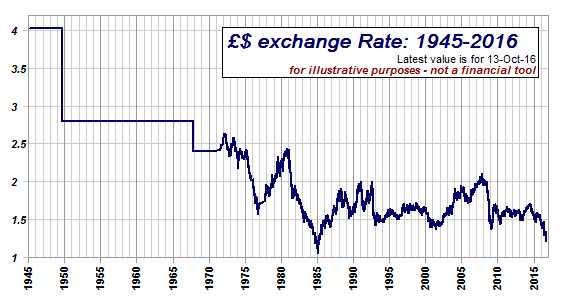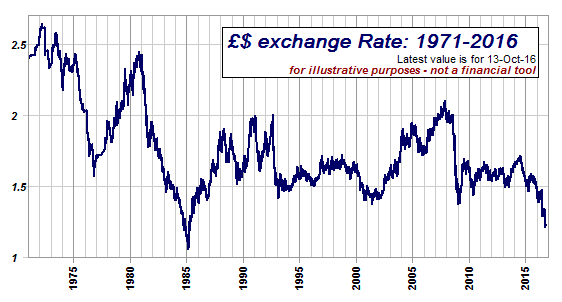Dollar History
1: from
1915
2: from
1940
3: from 1971
4: from
2008
Last update
(excluding graph):
19-Apr-2008
©1996-2009
Mike Todd
![]()
| << Dollar history from 1940 |
3: Dollar Exchange Rate from 1971
 By
1971, Britain had been free of the original Gold Standard for forty
years, although through its Bretton Woods agreement it had pegged the
pound on a "pseudo Gold Standard" since 1945.
By
1971, Britain had been free of the original Gold Standard for forty
years, although through its Bretton Woods agreement it had pegged the
pound on a "pseudo Gold Standard" since 1945.
Following the devaluation of the pound in 1967, the exchange rate was fixed at $2.40
Then, in 1971 the US suspended the ability to freely convert between currency and gold, and the last vestiges of the Gold Standard disappeared. Britain unpegged (floated) the pound and, in effect, the brakes were removed, and the freely-traded currency we see today was established.
The graph above shows the fixed rates up until 1971, and the subsequent variations of the floating pound/dollar over the following years.
The variability of the £/$ rate from 1971 is obviously substantial and can be seen more clearly in the graph below - from a high of $2.44 at the end of 1980, right down to a low of $1.05 (caused by the severe weakness of the pound) in February 1985.
 By
February, 1991, it had almost reached $2 and, after falling back, in
September 1992, it actually rose above $2 for the first time in 20 years.
By
February, 1991, it had almost reached $2 and, after falling back, in
September 1992, it actually rose above $2 for the first time in 20 years.
And then Norman Lamont (UK's Chancellor of the Exchequer) decided to take the pound out of the ERM.
This immediately devalued the pound, and the results were dramatic - the pound plummeted in value, falling to $1.75 within a month, and to just over $1.40 in five months.
Anyone starting a two-week holiday in early September, 1992, might have seen a $1000 hotel bill effectively rise by over £100 from the day they arrived to the day they actually paid the bill. And in six months the pound had been devalued by more than 25%.
From this point on, the exchange rate rose and fell fairly gently, hitting a low of $1.38 in June, 2001. Even the events of "9/11" seem to have had very little effect on the short term value of the dollar, but in January 2002 the dollar started a fairly steady drop in value, with the sterling rate reaching a peak towards the end of 2004 of $1.94.
Although the rate remained high for the first few months of 2005, a weakening pound and strengthening dollar started pushing the rate down. This trend was already in place before events of 7/7 in London, which actually appear to have had relatively little effect on the value of the pound. Through the remainder of 2005, the dollar continued to strengthen. The pount fell from its peak of about $1.93, and by the beginning of 2006 it was down to $1.73.
But the spring of 2006 saw America's economy in real trouble, caused by a combination of a lack of global confidence in the president, and the "sub-prime" mortgage crisis - property values dropped dramatically, loans couldn't be refinanced, and by August, 2007, the pound was heading through the $2 barrier and, during November, reached the heady heights of $2.11.
However, with a new president in the wings, global confidence in the US started to increase, and through 2008 the dollar strengthened hugely, and the pound dropped from a high of $1.99 to $1.44 by the end of the year.
| << Dollar history from 1940 |